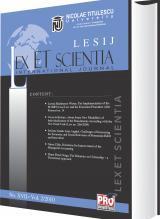ROMANIAN “FIDUCIA” AND GEORGIAN “TRUST” (MAJOR TERMINOLOGICAL SIMILARITIES AND DIFFERENCES)
ROMANIAN “FIDUCIA” AND GEORGIAN “TRUST” (MAJOR TERMINOLOGICAL SIMILARITIES AND DIFFERENCES)
Author(s): Irina GvelesianiSubject(s): Law, Constitution, Jurisprudence
Published by: Universitatea Nicolae Titulescu
Keywords: globalization; fiducia; Georgian; Romanian; trust
Summary/Abstract: Globalization - a complex system of innovation, internationalization and rapidly growing interdependence – plays the greatest role in the formation of today’s world. It enters different spheres of human life and stipulates the uniformity of economy, law, business and even, political life. In the framework of global processes, a lot of changes can be seen in the legal systems of European countries. The given paper discusses the formation of the Romanian “fiducia” and the Georgian “საკუთრების მინდობა” (sakutrebis mindoba – means “trust”) under the influence of Anglo-American “trust”. The term “trust” generally nominates an institution of Anglo-American law, which is irreplaceable in the cases when the real owner of the property must be substituted by the nominal one (trustee) for carrying out civil relationships. This concept originated in the English Common law, but has been constantly rejected by the European continental legal systems (Civil law). The main obstacle laid in the fact, that Anglo-American legal system was based on the duality of ownership, which was almost unacceptable for the continental law-governed countries. However, in the recent years, the growing importance of the American capital markets popularized the utilization of “trust” and stipulated its insertion in some “rigid” European jurisdictions. Moreover, some world countries have already indirectly allowed mechanisms similar to the “trust”. Among them are Romania and Georgia. The given research is dedicated to the precise description of the Romanian and Georgian “trust instruments”. It singles out major terminological units and underlines the fact that newly-established mechanisms have to undergo several stages for turning into faithful reflections of the original model of “trust”.
Journal: LESIJ - Lex ET Scientia International Journal
- Issue Year: XX/2013
- Issue No: 2
- Page Range: 60-66
- Page Count: 7
- Language: English

